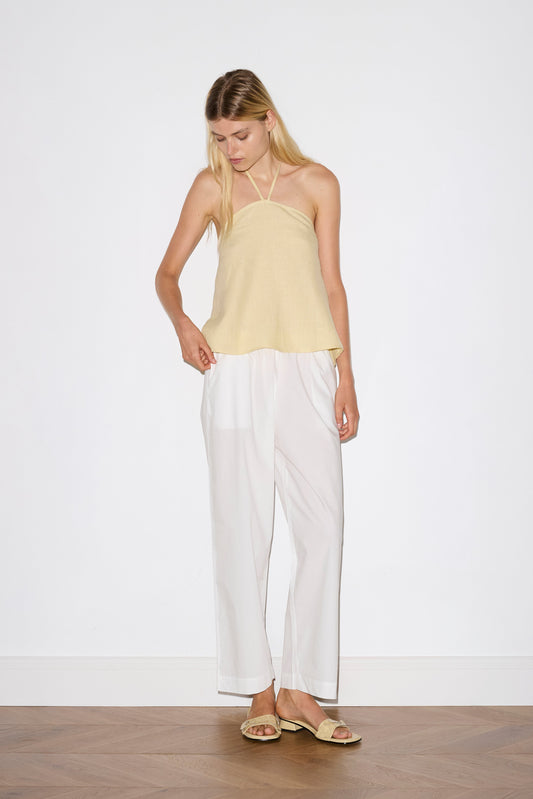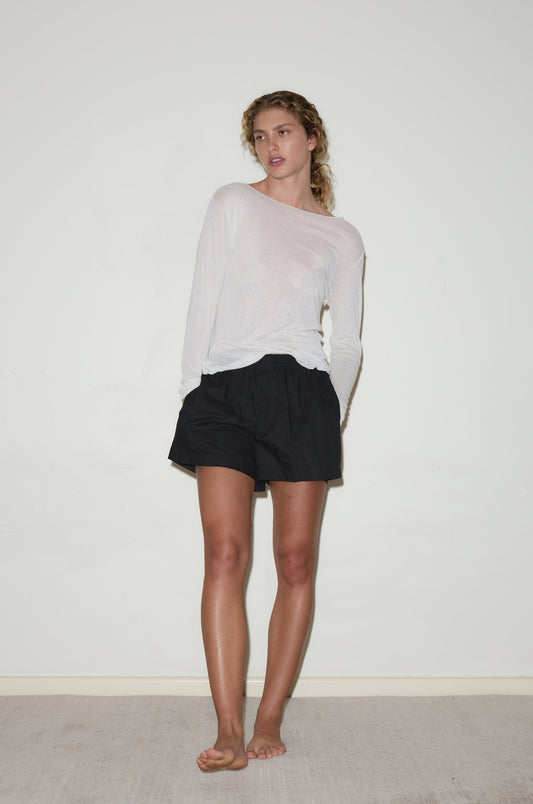WOMEN OF NOTE:
María-Elena Pombo | Artist
María-Elena Pombo is a multidisciplinary artist redefining the potential of the humble avocado. Using their seeds as her medium, through rigorous research and experimentation María-Elena crafts unexpected narratives to explore the Venezualan diaspora. Working under the moniker Fragmentario, her practice encompasses textiles, installation, photography and video, each element guiding her viewers and participants towards ideas they otherwise may never have considered before.
Here, María-Elena shares more with us wearing the Shirred Dress in her Brooklyn-based studio, dappled in morning light.
Location: Brooklyn, New York
Date: December 12, 2021
Time: 1:30pm
|
Where are you from and where are you now?
Are you a morning or evening person?
What is the first thing you do when you wake up?
Can you describe where you live and the view from your bedroom?
When did you first realise you wanted to be an artist? In 2016 I was about to start a new job in fashion as a senior designer. I had some weeks in-between jobs and took the time to map out what I would like to do after this job. I have a habit which is both great and terrible to always plan two steps ahead. I knew I didn’t want to have a job in fashion anymore, but I had a hard time imagining something concrete so I decided to write keywords to function as pillars for whatever this house would be: culture, time, community. From these words I came up with the word Fragmentario, as a vessel for these ideas and opened an Instagram account to share some work and process. I wanted the anonymity of a moniker. I didn’t want my employer to know and I wanted to avoid friends saying they liked this work just to be nice. I don’t think I thought of myself as an artist for the first couple years. I would get uncomfortable when people used that word (or any really) to define me. I don’t like labels in general, as I feel they are limiting. I also like clear language and I feel this word has so many different interpretations depending on the context, that it sometimes doesn’t serve the purpose of communication. I kept doing my work and trying to reframe this word that felt very heavy. In 2019 I had a show in Osaka in an art space named Yamamoto-Seika that shifted my perspective a lot. Not the act of showing itself, but the conversations that arose with the curators during the months of preparation and with the spectators during the exhibition. After the show, the founder of the space recommended some books and questions for me to figure out. He basically gave me some homework that provided a GPS for a route I had been navigating without a map. I think those two moments were, respectively, the one in which I realized I wanted to be an artist, and the one in which I had the words for it. |
|
|
 |
What does a day in your studio look like for you at the moment?
Avocado seeds are a vital resource that continues to inform your practice. Can you tell me a little bit about the significance of using this medium? As a material, the avocado seed is quite multifaceted, which allows endless experimentation. On an immaterial level, I feel everyone I encounter has so many opinions about avocados. Either people telling me they like to eat 100 avocados a day, or people who get very upset believing I am somehow promoting greater consumption of avocados. I like to provoke conversations and the seeds do this. I feel like it’s a democratic medium that allows anyone (not everyone) to access my work, even with readings I didn’t anticipate. The reason I have access to so many avocado seeds, a material that has many positive connotations for me, is a model of overconsumption and extractivism with many complicated repercussions. I embrace that duality. It mirrors life. Some specific words that I associate with this medium, in the context of my work, are resilience, transformation, as well as culture, time and community, the original keywords for this experiment of Fragmentario
Your most recent exhibition Entrelazados 3D et al. plays with the concept of interweaving and interleaving, bridging the gap between the physical and the digital as a way for viewers to explore time and space. How did the concept for this show come about? Some people think they are color studies, but their main purpose is to explore space. Until this show, I worked with them in two-dimensional space. I have been wanting for some time to add this third dimension. I wanted people to be able to enter the pieces, not just look at them. The previous year I had created an ‘entrelazado’ outside a concrete factory and as much as I loved presenting in a public space, I was also curious to see how differently people would interact with them indoors. The ‘et al.’ in the name referred to four reimagined fountains. A bathtub filled with avocado seed water, a sink filled with avocado seed water and baking soda (to make the water more basic), a sink filled with avocado seed water and lime juice (to make the water more acidic) and a glass container with iron mixed into water. The first three were given to me by a wood shop on a forgotten street I found while running. Visitors received 6 test tubes to collect water samples from these fountains and mix them. There were also rolls of my avocado seed dyed fabrics that visitors could unroll and position in the space. It was interesting to see how different personalities interacted with it. Some just wanted to sit inside of the pieces, others made their own entrelazados, and others even wove themselves into it.. I showed earlier this year at the London Design Biennale ‘La Rentrada’, a project that was very research-driven and dominated my last two years. The exhibition was heavily regulated, being in Somerset House, a historical building. After that I needed to work on something that was the exact opposite: coming from a place of intuition, no regulations, and promoting interaction. I wasn’t planning on creating it so soon after the London Design Biennale, but I found a grant, applied, and was able to put it together thanks to this.
|
|
If you find yourself feeling uninspired, how do you find motivation again?
During your down time at home, what do you like to do in your spare time?
Is there a recipe that you find yourself returning to? If so, would you like to share it with us here?
If you could have a dinner party with any three artists, who would you choose to dine with?
What are you currently watching, reading and listening to?
Before you go to bed, how do you unwind?
What do you dream of while you sleep?
María-Elena wears the shirred dress in white. See more of her artwork here.
Interviewed by Chloe Borich for Deiji Studio’s Field Notes Photographed by Griffin Moore. |
|









